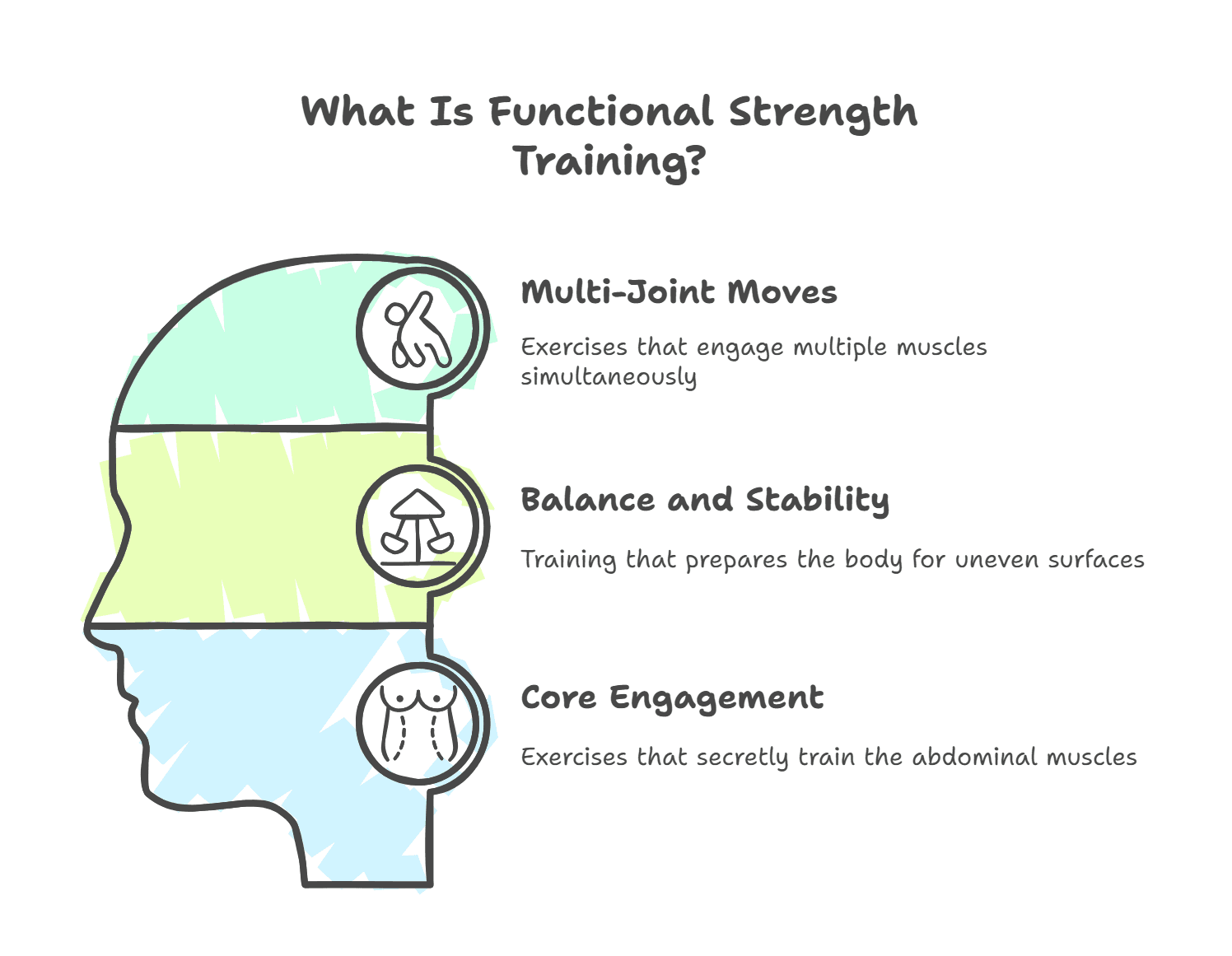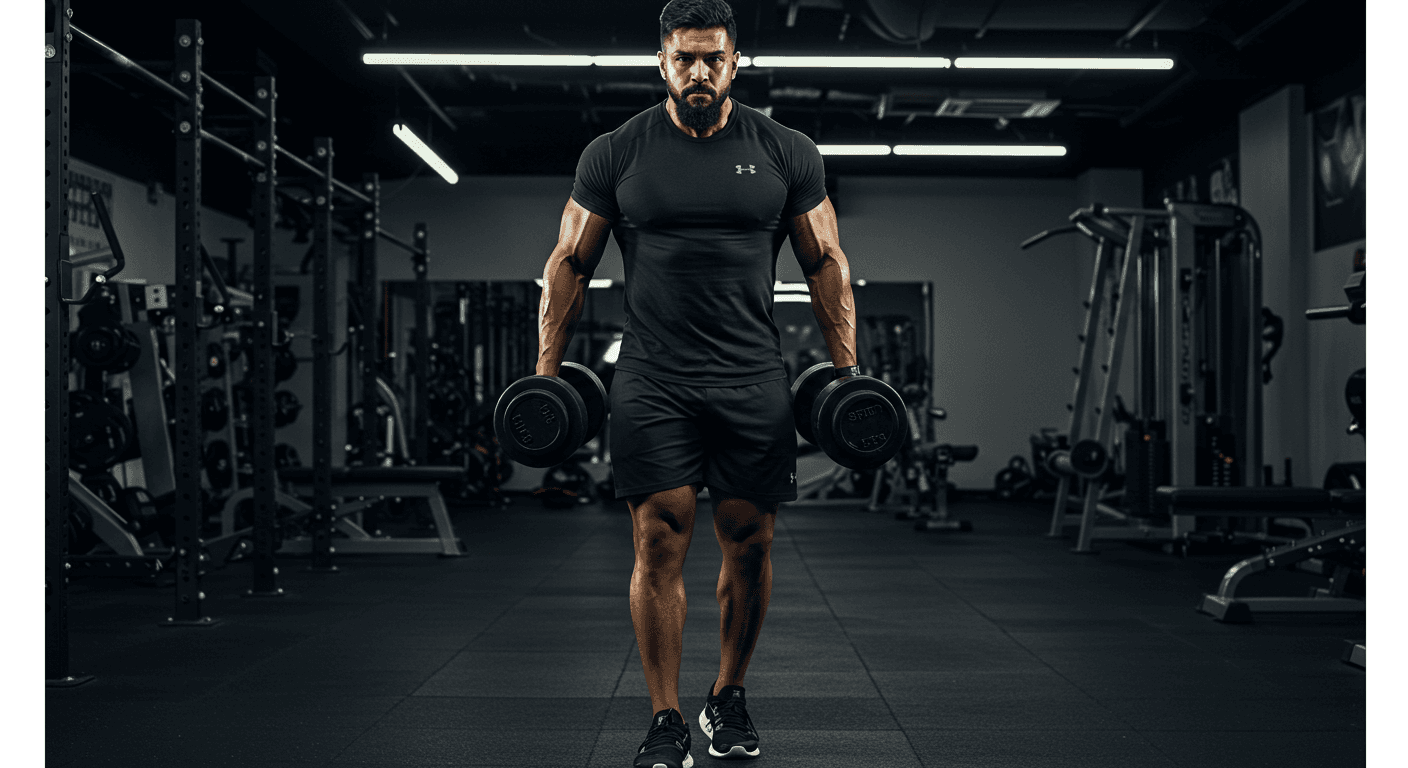
Ever notice that guy who effortlessly carries all the groceries in one trip or swings his kid around the park like it’s nothing? That’s not luck that’s the power of functional strength training. Blending practical strength with traditional workouts, functional strength training prepares your body for real-life moves, whether it’s daily chores, weekend sports, or adventurous activities.
Let’s dive into exactly what functional strength training is, how it compares to traditional methods, and why it’s your next fitness cheat code.
Table of Contents
What Is Functional Strength Training? (Spoiler: It’s Not Just Rehab)
At its core, functional strength training means training your body through movements you use every day. Forget isolated exercises like the classic bicep curl, functional training engages multiple muscles and joints simultaneously, improving coordination and efficiency. Think squats, lunges, kettlebell swings, or push-ups. You’re not just working muscles; you’re training movements.
The core principle is simple: functional training focuses on enhancing your ability to perform daily tasks or sports-specific activities. It’s fitness that mirrors life, prepping your body for anything from carrying groceries to conquering a rock climb.

Studies show it boosts athletic performance, reduces injury risk, and even helps older adults stay independent. Translation: It’s the gym equivalent of learning to parallel park annoying at first, but a lifesaver.
Functional Strength Training vs Traditional Strength Training: What’s the Real Difference?
Let’s settle the gym beef. Traditional training is like a luxury sports car: sleek, powerful, but only on a track. Functional training is the 4×4 Jeep less flash, but ready for off-road chaos.
How different can it really be?” Here’s the scoop:
- Movement Patterns vs. Muscle Isolation:
Traditional strength workouts typically isolate individual muscles, like doing a seated bicep curl or leg extension. In contrast, functional strength training combines multiple muscle groups and joints, like performing a lunge with an overhead press. Your body learns to coordinate multiple actions at once, just as it naturally does outside the gym. - Equipment & Environment: Traditional strength training usually requires gym equipment fixed-path machines and barbells. Functional training can use minimal equipment, such as dumbbells, kettlebells, resistance bands, or even just your body weight. This makes functional exercise workouts accessible anywhere, anytime.
- Goals and Results: Traditional strength training aims primarily at increasing muscle size (hypertrophy) and lifting heavier weights (think: bench pressing heavier). Functional strength training aims for functional improvement improving how well you move, enhancing your balance, stability, and agility, and making everyday tasks easier.
Difference Between Functional and Traditional Strength Training: Quick Breakdown
| Feature | Functional Strength Training | Traditional Strength Training |
| Movements | Compound, integrated | Isolated muscle groups |
| Goals | Mobility, coordination, real-world strength | Muscle mass, maximal strength |
| Equipment | Free weights, bands, bodyweight | Machines, barbells |
| Training Style | Dynamic circuits, varied movements | Fixed sets, isolated movements |
Neither is “better” but together, they’re unbeatable. Your body thrives on variety. Functional training unlocks your real-world capabilities, while traditional methods push your muscular limits. Mixing them lets you truly explore every boundary of your fitness potential.
Example: A leg press (traditional) bulks up your quads. A lunge with a suitcase (functional) builds quads plus balance, core stability, and grip strength , skills you’ll use hauling groceries up five flights when the elevator’s busted.
Can You Lose Weight With Functional Training?
Yes, you can lose weight with functional training. But here’s the thing it’s not a magic bullet. Functional exercise workouts significantly boost calorie burn because you’re recruiting multiple muscles at once, often elevating your heart rate throughout the session. Studies back this up: middle-aged adults engaging in functional workouts reduced body fat by around 3.2% more than those following traditional weight routines.
Why is that? Functional workouts trigger higher Excess Post-exercise Oxygen Consumption (EPOC), meaning your body keeps burning calories even after your session is over. Functional circuits like performing jump squats, burpees, and mountain climbers essentially blend cardio and strength into a single session, making them an effective option for fat loss.
But let’s keep it real: nutrition is still key. Functional training alone won’t magically erase body fat unless paired with a balanced diet.
Can You Lose Weight With Functional Training Alone?
Yes but combining it with other exercise types, like traditional weightlifting and moderate cardio, usually leads to even better results. Functional training efficiently packs strength and cardio elements together, but for ultimate fat loss and muscle preservation, a diverse approach helps.
Functional Exercise Workout: Your New Weekly Routine

Here’s an easy-to-follow functional exercise workout that anyone from beginners to fitness enthusiasts can integrate into their routine:
Beginner Routine (Home Edition):
- Bodyweight squats: 3×12 (pretend you’re sitting in a lawn chair).
- Incline push-ups: 3×10 (use your kitchen counter, no judgment).
- Farmer’s carry: Walk 40 feet with heavy grocery bags (bonus: unpack them afterward).
Advanced Shred (Park or Gym):
- Kettlebell swings: 4×15 (hips drive the motion, not your arms , form is key).
- Single-leg deadlifts: 3×8 per leg (balance challenge = core engagement).
- Battle ropes: 30 seconds on, 30 off (cardio meets arm day).
Pro move: Add rotation like a lunge with a medicine ball twist to mimic turning to grab your kid mid-tantrum.
Perform each exercise with minimal rest (20-30 seconds), then rest for a minute after each circuit. Repeat 3 times. This “functional exercise workout” hits your major muscle groups and elevates your metabolism both during and after your session.
Practical Insights: Combining Functional and Traditional Training
From personal experience, mixing functional exercises with traditional strength training lets you explore and push your body’s limits. Think of traditional lifts (bench presses, heavy deadlifts) as building your foundational muscle. Then, functional movements (lunges with twists, medicine ball throws, or even basic calisthenics) help convert raw strength into practical power, agility, and coordination.
Together, they equip you with strength you can actually use inside and outside the gym.
Even if you’re new to fitness, alternating between functional circuits and traditional strength days ensures you build a versatile, resilient body. You’ll not only get stronger you’ll move better.
Who Can Benefit Most?
- Beginners: Functional exercises are perfect because they can start simple (like bodyweight squats) and gradually progress to more challenging moves.
- Older Adults: Functional training supports independence by directly enhancing balance and mobility, crucial for everyday activities.
- Athletes: Improve sport-specific movements like explosive jumps or directional changes that traditional lifting alone might not fully address.
Myths Busted:
- “Functional training neglects isolated muscle groups.”
Not entirely true it’s just not the focus. Functional routines improve muscular balance and coordination but pairing them with traditional isolated lifts (like bicep curls) ensures comprehensive muscle development. - “Functional training is only for athletes.”
Nope. Everyone from office workers to grandparents benefits from improved coordination and reduced injury risk in everyday activities. It’s genuinely fitness for everyone.
How to Start Your Functional Exercise Workout Routine
- Warm-Up (5-7 mins): Jumping jacks, dynamic stretches, and joint mobility exercises.
- Circuit Training: Choose 4-6 functional exercises targeting different muscle groups.
- Cool Down: End with gentle stretching or yoga poses to enhance flexibility and recovery.
Adjust intensity by adding weight or shortening rest periods. The best workouts are those you’ll stick with, so keep them fun, varied, and realistic.
Consistency beats intensity start small, stay consistent, and increase the challenge as you progress.
For variety, sprinkle in some calisthenics occasionally bodyweight exercises like pull-ups or dips to challenge your strength from different angles
Wrapping it All Up
After years of lifting, I’ve discovered that combining functional training with traditional methods is the sweet spot. Neither approach alone gives you the complete picture you need both to truly push your body’s limits and capabilities.
Functional strength training is your body’s “cheat code” teaching it to perform efficiently under real-life conditions. It’s not about ditching traditional strength routines; it’s about enriching them. Incorporating functional exercises alongside traditional training will help you build balanced strength, improve movement quality, prevent injuries, and boost fat loss.
Want to experience real-world strength? Blend the best of both worlds. Your groceries and your body will thank you. Got a favorite functional exercise? Drop it in the comments below let’s keep leveling up together.
What exactly is functional strength training, and why should I care?
Functional strength training involves exercises that mimic everyday movements (like squatting, lifting, and pulling). It improves your ability to handle daily activities effortlessly and reduces injury risk, making you stronger where it matters most.
Can functional exercise workouts really help me lose weight?
Definitely! Functional workouts engage multiple muscles simultaneously, boosting your metabolism and burning calories both during and after the workout. Pair it with good nutrition, and you’ve got an effective formula for shedding fat.
Should I combine functional and traditional strength training?
Absolutely blending functional exercises with traditional strength training allows you to build raw muscle strength and then translate it into practical, real-world movement. It’s the ultimate strategy for balanced fitness.
